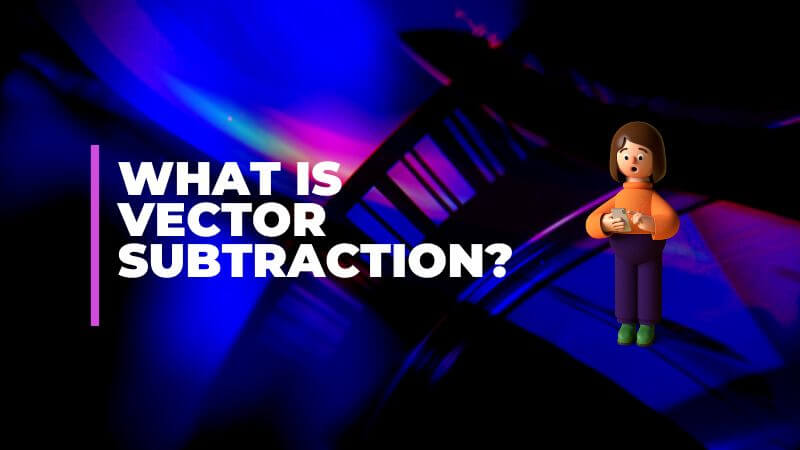In this piece, we will delve into the idea of vector subtraction, as well as its properties and various applications in the real world.
Vectors are extremely important in the field of mathematics, particularly when it comes to the representation of physical quantities like displacement, velocity, and force.
As a result of the fact that these mathematical entities have both magnitude and direction, they are indispensable in a wide variety of applications in science and engineering.
Subtraction, an essential operation involving vectors, enables us to determine the distance that separates two vectors and is, therefore, one of the fundamental operations involving vectors.
In this piece, we will delve into the idea of vector subtraction, as well as its properties and various applications in the real world.
Understanding Vector Subtraction
Before diving into vector subtraction, it’s crucial to grasp the basics of vectors. A vector can be represented as an arrow with a specific length (magnitude) and direction. Each vector has a starting point, known as its tail, and an endpoint, known as its head. Vector subtraction involves finding the resultant vector when one vector is subtracted from another.
In terms of geometry, the process of subtracting one vector from another can be thought of as moving in the opposite direction of the vector that is being subtracted.
Take into consideration the vectors A and B. To perform the subtraction of vector A from vector B, we can invert the positions of the heads and tails of both vectors. The resultant vector, denoted by C, represents the movement from the endpoint of A to the beginning point of B.
Finding the vector that links the starting point of A to the finishing point of B is another way to think about this process, which can be understood as the same thing.
Mathematical Representation Of Vector Subtraction
In mathematical terms, vector subtraction is performed by subtracting the corresponding components of the vectors. Suppose we have two vectors A and B in a two-dimensional Cartesian coordinate system:
A = (A<sub>x</sub>, A<sub>y</sub>)
B = (B<sub>x</sub>, B<sub>y</sub>)
The subtraction of vector B from vector A can be represented as:
C = A – B = (A<sub>x</sub> – B<sub>x</sub>, A<sub>y</sub> – B<sub>y</sub>)
Similarly, in a three-dimensional space, the vector subtraction is performed component-wise:
C = A – B = (A<sub>x</sub> – B<sub>x</sub>, A<sub>y</sub> – B<sub>y</sub>, A<sub>z</sub> – B<sub>z</sub>)
Properties of Vector Subtraction
Vector subtraction exhibits several important properties that make it a valuable tool in mathematical and physical analyses:
1. Commutative Property: Vector subtraction is not commutative, meaning that changing the order of subtraction leads to different results. A – B is not equal to B – A, except in special cases where A and B have the same magnitude and direction.
2. Associative Property: Vector subtraction obeys the associative property. For three vectors A, B, and C, (A – B) – C is equal to A – (B + C), where + represents vector addition.
3. Zero Vector: When a vector is subtracted from itself, the result is a zero vector, which is represented by the symbol 0. A – A = 0. The magnitude of the zero vector is zero, and it points in no particular direction.
Applications of Vector Subtraction
Vector subtraction finds extensive applications across various fields, including physics, engineering, and computer graphics. Here are a few practical examples:
1. Relative Motion: Vector subtraction is employed to determine the relative motion between objects moving in different directions. By subtracting the velocity vector of one object from another, we can obtain the relative velocity between them.
2. Force Analysis: In physics and engineering, vector subtraction is used to analyze forces acting on an object. By subtracting the forces acting in one direction from those acting in the opposite direction, we can calculate the net force experienced by the object.
3. Computer Graphics: Vector subtraction is instrumental in computer graphics for rendering three-dimensional scenes. It helps determine the direction and intensity of light sources, enabling the creation of realistic lighting effects.
4. Navigation and GPS: To calculate distances and headings, GPS systems use a technique called vector subtraction. The GPS can calculate the vector that represents the distance between two locations by taking the coordinates of the two locations and subtracting them from each other.
Frequently Asked Questions
How do you subtract two vectors?
Does vector subtraction exist?
What are the properties of vector subtraction?
It is the vector with an equal magnitude of a but in the opposite direction.
Why is vector subtraction commutative?
Summary!
The difference between two vectors can be found by using a fundamental operation called vector subtraction, which allows us to see the difference between the vectors.
A new vector representing the displacement between the end of the first vector and the beginning of the second vector can be obtained by taking the corresponding components and subtracting them from each other.
This mathematical operation is useful in a wide variety of fields, such as physics, engineering, computer graphics, and navigational systems, to name a few of them.
Anyone who works with vectors needs to have a solid grasp of the concept of vector subtraction because it serves as a stepping stone toward becoming an expert in the complexities of vector analysis.
This understanding is required for anyone who works with vectors. Hope you liked this amazing article on vector subtraction. Leave your thoughts in the comments below.
Also Read: Angle Addition Postulate: A Complete Guide
Tinydale is on YouTube, Click here to subscribe for the latest videos and updates.
Follow Us: Facebook | Instagram | Twitter | Youtube | Pinterest


